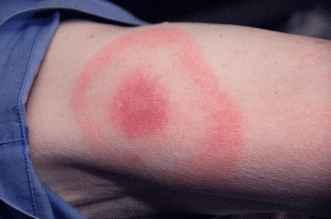
Written by Dr. Diane Mueller
Most commonly the rash from Lyme appears in 7-14 days. It may be as little as 1 day after infection or as long as 30 days. Most people if they are bit by a tick look out for the rash as a way of identifying if they have Lyme Disease or not. This is not the best way of determining this as Lyme Disease does not always lead to the development of a rash. Check out more information on the blog post, Lyme disease rash about the rash itself.

If you know you have had a tick bite, the best thing to do is remove the tick and send it in for evaluation to see if it carries Lyme Disease.
Ticknology is a company that offers this sort of evaluation, but there are other companies on the market as well. If the tick carries Lyme Disease, you will want to assume you are infected. If the tick does not carry Lyme Disease, you are off the hook for this.
Have Lyme Disease or suspect you do?
Knowing the timeline of a Lyme disease rash can be a game-changer in catching the illness early. It’s not just about knowing what to look for, but also about understanding when and how it might appear. So buckle up, and let’s unravel the mystery of this classic symptom together!
Let’s break down the stages of the Lyme disease rash, known as Erythema migrans. It doesn’t just pop up out of nowhere!
A Lyme disease rash usually takes time to appear, typically within 7 to 14 days after infection. But it can show up as early as 1 day or as late as a whole month! Just because you got a tick bite doesn’t mean you’ll instantly see the rash. And get this – sometimes Lyme disease doesn’t even cause a rash.
Once the Lyme disease rash enters, it spreads out from the tick bite spot. It can go from small red spots to 12 inches wide! You might see that classic “bull’s-eye” pattern with a clear center as it gets bigger. But not every rash looks like a dartboard, so don’t be fooled.
Here’s the kicker – the Lyme rash can vanish, even without treatment. But don’t let that trick you into thinking the Lyme disease is gone, too. Without proper care, you could end up with some severe problems, like issues with your brain or heart. If you spot a Lyme disease rash, always get checked out by a doctor.
Ticks are like walking Petri dishes – they can carry all sorts of nasty infections besides Lyme. So, just because a tick doesn’t have Lyme doesn’t mean it’s harmless. There are fantastic companies out there, like Ticknology, that can test ticks for a whole bunch of diseases. And let’s be honest: Lyme disease testing in humans could be done. So if you get bit, it’s wise to go for the complete tick check-up.
But before you rush off to the lab, make sure you remove the tick the right way. Grab some tweezers, latch onto the tick, and pull it without twisting it. Then, clean the spot with some Andrographis tincture or hydrogen peroxide if you’re in a pinch. But don’t stop there! While waiting for the tick test results, starting herbal treatments, like cat’s claw or Japanese knotweed is a good idea. Make sure to collaborate with a Lyme-savvy doctor who can keep you in the loop on the latest research. Remember, the Lyme rash can show up anywhere from 1 to 30 days after the bite, so keep a close eye on your health during that time, even if you start the herbal stuff early.
To remove a tick properly, use the following methodology: take tweezers and hook as you twist and pull out. Treat the area with a tincture of Andrographis. If you do not have this, hydrogen peroxide can work. Store the tick in a sealed container and order a tick test from a company like Ticknology (or you can use Tick Report, another good tick testing company). While waiting to hear back from the company, you can begin herbal treatment with herbs such as cat’s claw and Japanese knotweed. Working with a Lyme Literate Doctor who can help educate and guide you according to the most up-to-date research is even better.
Spotting the rash early is excellent for lowering your risk of Lyme disease, but preventing tick bites in the first place is even better. Wear long sleeves and pants, and pick light colors to spot ticks easily. Tuck your pants into your socks to keep ticks from crawling up your legs. And don’t forget the EPA-approved bug spray with DEET, picaridin, IR3535, or oil of lemon eucalyptus. Just follow the label instructions!
After your outdoor adventure, do a full-body tick check, especially in sneaky spots like under your arms, in and around your ears, inside your belly button, behind your knees, in your hair, between your legs, and around your waist. Hop in the shower within 2 hours of coming inside to wash off any ticks that haven’t latched on yet.
Knowing what the Erythema migrans rash looks like and when it might appear is a great start. But don’t be fooled if the rash disappears—that doesn’t mean the Lyme disease is gone, either. Talk to a Lyme-literate doctor for guidance and stay on top of your health, especially in the month after a tick bite.
Don’t forget that ticks can carry all sorts of nasty bugs besides Lyme, leading to co-infections. So, testing ticks for different diseases is super important. Prevention is also crucial—from dressing right and using bug spray to keeping your yard in check and using pesticides carefully, every little bit helps.
Remove the tick properly and start herbal treatments ASAP if you get bit. Stay alert and stay safe!
At our medical clinic, most of the people that we find positive for Lyme Disease through testing do not remember a tick bit or ever having the classic Lyme Disease Rash.
For more information on the topic of Lyme Disease Rash, see our other blog:
References:
[1] Murray TS, Shapiro ED. Lyme disease. Clin Lab Med. 2010 Mar;30(1):311-28. doi: 10.1016/j.cll.2010.01.003. PMID: 20513553; PMCID: PMC3652387.
[1] Skar GL, Simonsen KA. Lyme Disease. [Updated 2022 May 6]. In: StatPearls [Internet]. Treasure Island (FL): StatPearls Publishing; 2022 Jan-. Available from: https://www.ncbi.nlm.nih.gov/books/NBK431066/
Free Lyme/Mold Webinar: "Why Am I Still Sick?"
Have Lyme Disease or suspect that you do?
We have helped thousands of
people restore their health
and quality of life by diagnosing
and treating their Lyme Disease.
“Dr. Mueller’s approach to medicine is refreshing! There is only so much you can do with western medicine and in my life I was needing a new approach. By addressing the whole body, nutritional diet factors, environmental factors, blood work, and incorporating ideas I had not previously known, I was able to break through with my conditions. I am not only experiencing less pain in my life, but through the process of healing guided by Dr. Diane Mueller, I am now happy to say I have more consciousness surrounding how I eat, what to eat and when things are appropriate. Living by example Dr. Mueller has a vibrancy that makes you want to learn and know more about your body and overall health. I highly recommend her to anyone looking for new answers, a new approach to health, or in need of freedom from pain and limitations.”
-Storie S.
Kihei, HI
Lyme Disease is Often Misdiagnosed as Fibromyalgia, Chronic Fatigue, Depression,
or Other Illnesses
Have Lyme Disease or suspect you do?
